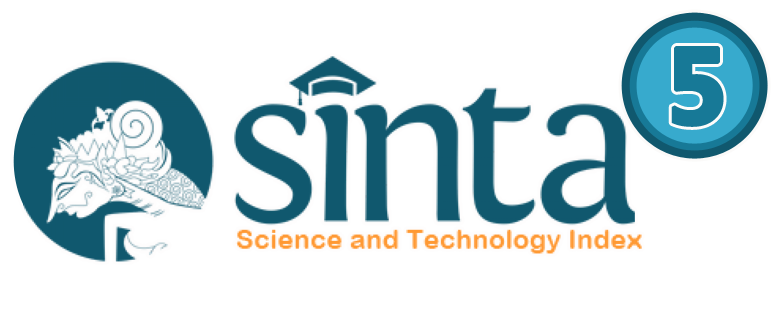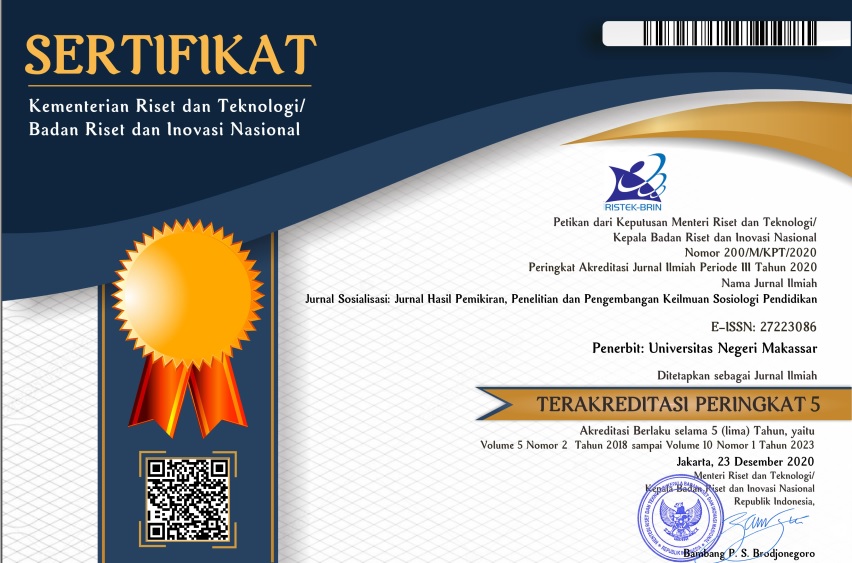Urgensi Bahasa Isyarat dalam Pendidikan Formal sebagai Media Komunikasi dan Transmisi Informasi Penyandang Disabilitas Rungu dan Wicara
(1) Universitas Negeri Surabaya
(2) Universitas Negeri Surabaya
(*) Corresponding Author
DOI: https://doi.org/10.26858/sosialisasi.v1i1.31732
Abstract
Communication and transmission of information have a major role in human life. The presence of barriers caused by limited information and sign language skills can create gaps and communication failures. As a result, people with disabilities and speech often experience lag in their environment. This paper uses qualitative research methods, with literature study techniques. Overall, the integration of sign language into the curriculum will enable the development of a deaf culture. Applying sign language in a formal educational environment benefits both individuals with disabilities and individuals without disabilities.
Keywords
Full Text:
PDFReferences
Bennett, J. M. (2016). Deaf Gain: Raising the Stakes for Human Diversity . . Journal of Disability & Religion, 20(3), 229–232. https://doi.org/10.1080/23312521.2016.1203142
Borotan, A. (2019). LI’AN BAGI SUAMI YANG TUNAWICARA (TELA’AH TERHADAP PEMIKIRAN IMAM ABU HANIFAH 80 H/699 M – 150H/767 M) [Universitas Islam Negeri Sultan Syarif Kasim Riau]. In Jurnal Hukum Islam (Vol. 2, Issue 2). http://repository.uin-suska.ac.id/id/eprint/24948
Bowman-Smart, H., Gyngell, C., Morgan, A., & Savulescu, J. (2019). The moral case for sign language education. Monash Bioethics Review 2019 37:3, 37(3), 94–110. https://doi.org/10.1007/S40592-019-00101-0
Espinosa, L. (2013). PreK-3rd: Challenging Common Myths About Dual Language Learners, An Update to the Seminal 2008 Report | Foundation for Child Development. Foundation For Child Development, August. http://fcd-us.org/resources/prek-3rd-challenging-common-myths-about-dual-language-learners-update-seminal-2008-report
Fardila, U. A. (2018). Effective Communication for Special Needs Children Educators. JARES (Journal of Academic Research and Sciences), 3(2), 20–32. https://doi.org/10.35457/jares.v3i2.491
Fitzpatrick, E. M., Stevens, A., Garritty, C., & Moher, D. (2013). The effects of sign language on spoken language acquisition in children with hearing loss: a systematic review protocol. Systematic Reviews, 2, 108. https://doi.org/10.1186/2046-4053-2-108
Golos, D. B., Moses, A. M., Roemen, B. R., & Cregan, G. E. (2018). Cultural and linguistic role models: A survey of early childhood educators of the deaf. Sign Language Studies, 19(1), 40–74. https://doi.org/10.1353/sls.2018.0025
Golos, D., Moses, A., Gale, E., & Berke, M. (2021). Building Allies and Sharing Best Practices: Cultural Perspectives of Deaf People and ASL Can Benefit All. LEARNing Landscapes, 14(1), 97–110. https://doi.org/10.36510/LEARNLAND.V14I1.1028
Hallahan, D. P., Pullen, P. C., Kauffman, J. M., & Badar, J. (2020). Exceptional Learners. Oxford Research Encyclopedia of Education, 1–21. https://doi.org/10.1093/acrefore/9780190264093.013.926
Hamilton, D. (1990). Learning about Education An Unfinished Curriculum. Open University Press.
Humphries, T., Kushalnagar, P., Mathur, G., Napoli, D. J., Padden, C., Rathmann, C., & Smith, S. R. (2012). Language acquisition for deaf children: Reducing the harms of zero tolerance to the use of alternative approaches. Harm Reduction Journal, 9, 1–9. https://doi.org/10.1186/1477-7517-9-16
Liliweri, A. (2003). Makna budaya dalam komunikasi antar budaya. Lembaga Kajian Islam dan Studi (LKiS).
Moret, M. C. F. F., Mendonça, J. G. R., & Santos, L. C. M. dos. (2021). Pedagogical practices in the literacy process of deaf students. Laplage Em Revista, 7(3B), 36–42. https://doi.org/10.24115/s2446-6220202173b1482p.36-42
Moses, A. M., Golos, D. B., & Bennett, C. M. (2015). An Alternative Approach to Early Literacy: The Effects of ASL in Educational Media on Literacy Skills Acquisition for Hearing Children. Early Childhood Education Journal, 43(6), 485–494. https://doi.org/10.1007/s10643-015-0690-9
Mulyana, D. (2002). Ilmu komunikasi suatu pengantar. Remaja Rosdakarya.
Padden, C., & Ramsey, C. (1993). Deaf culture and literacy. American Annals of the Deaf, 138(2), 96–99. https://doi.org/10.1353/aad.2012.0623
Pratiwi, A., Lintangsari, A. P., Rizky, U. F., & Rahajeng, U. W. (2018). Disabilitas dan pendidikan inklusif di perguruan tinggi. Universitas Brawijaya Press.
Umiarso, & Elbadiansyah. (2014). Interaksionisme simbolik dari era klasik hingga modern (Ed. 1. Cet). Rajawali Pers.
Wiranda, N., & Putro, A. E. (2019). Model Identifikasi Kata Ucapan Tuna Wicara. IJEIS (Indonesian Journal of Electronics and Instrumentation Systems), 9(2), 131. https://doi.org/10.22146/ijeis.47609
Wood, J. T. (2013). Komunikasi teori dan praktik (komunikasi dalam kehidupan kita) (Ed. 6). Salemba Humanika.
Yanda, R. A., Haetami, M., & Hidasari, F. P. (2018). Pengaruh Metode Drill Pada Renang Gaya Dada Untuk Peserta Didik Tuna Wicara Di Sekolah Luar Biasa Dharma Asih. Jurnal Pendidikan Dan Pembelajaran Khatulistiwa, 7(7), 1–9.
Zulpicha, E. (2017). Konflik Kebijakan Penggunaan Sistem Bahasa Isyarat Indonesia di Lingkungan Pendidikan Formal. Jurnal Analisa Sosiologi, 6(1), 100–109.
Article Metrics
Abstract view : 413 times | PDF view : 119 timesRefbacks
- There are currently no refbacks.

This work is licensed under a Creative Commons Attribution 4.0 International License.


































